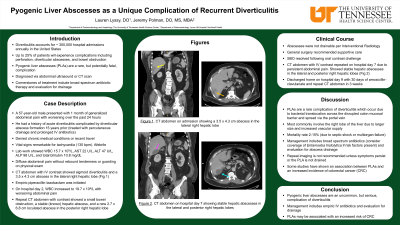Tuesday Poster Session
Category: Liver
P4772 - Pyogenic Liver Abscesses as a Unique Complication of Recurrent Diverticulitis
Tuesday, October 29, 2024
10:30 AM - 4:00 PM ET
Location: Exhibit Hall E

Has Audio

Lauren A. Lyssy, DO
The University of Tennessee Health Science Center
Memphis, TN
Presenting Author(s)
Lauren A. Lyssy, DO1, Jeremy Polman, DO, MS, MBA2
1The University of Tennessee Health Science Center, Memphis, TN; 2Lenox Hill Hospital, Northwell Health, New York, NY
Introduction: Up to 25% of patients hospitalized for diverticulitis will develop complications, such as perforation, diverticular abscess formation, and bowel obstruction. Pyogenic liver abscesses (PLAs) are a rare, but potentially fatal, complication of diverticulitis. Here, we discuss an interesting case of a patient developing multiple PLAs in the setting of recurrent diverticulitis.
Case Description/Methods: A 57-year-old male presented with 1 month of generalized abdominal pain, which had significantly worsened over the past 24 hours. He had a history of acute diverticulitis complicated by diverticular abscess formation 15 years prior, which resolved following abscess drainage and prolonged antibiotics. He otherwise denied chronic medical conditions or recent travel. On admission, he was tachycardic (130 bpm) without fever or hypotension. Lab work showed WBC 15,700, AST 22, ALT 47, ALP 98, and total bilirubin 0.8. Physical exam demonstrated diffuse abdominal pain without rebound tenderness or guarding. CT abdomen showed sigmoid diverticulitis without extraluminal gas and a 3.5 x 4.3 cm abscess in the lateral right hepatic lobe (not drainable per Radiology). Empiric piperacillin-tazobactam was initiated. On hospital day 2, WBC increased to 19,700 and the patient reported acute worsening of generalized abdominal pain. Repeat CT abdomen showed a small bowel obstruction, a stable (known) hepatic abscess, and a new 2.7 x 6.8 cm loculated abscess in the posterior right hepatic lobe. The abscesses remained undrainable due to position per Radiology. General surgery was consulted and recommended supportive care. An oral contrast challenge was performed on hospital day 5 followed by resolution of the bowel obstruction. The patient’s abdominal pain and leukocytosis improved. The blood cultures collected on admission showed no growth. He was discharged on hospital day 7 with 30 days of amoxicillin-clavulanate and a repeat CT abdomen scheduled in 3 weeks.
Discussion: PLAs develop in patients with diverticulitis due to the spread of bacteria via the portal vein. Management typically includes abscess drainage and a prolonged course of antibiotics. Repeat imaging is not recommended unless symptoms persist, or the PLA is not drained (as in this patient). A future outpatient colonoscopy was recommended not only due to this patient’s age, but also as some studies have shown an association between PLAs and an increased incidence of colorectal cancer.
Disclosures:
Lauren A. Lyssy, DO1, Jeremy Polman, DO, MS, MBA2. P4772 - Pyogenic Liver Abscesses as a Unique Complication of Recurrent Diverticulitis, ACG 2024 Annual Scientific Meeting Abstracts. Philadelphia, PA: American College of Gastroenterology.
1The University of Tennessee Health Science Center, Memphis, TN; 2Lenox Hill Hospital, Northwell Health, New York, NY
Introduction: Up to 25% of patients hospitalized for diverticulitis will develop complications, such as perforation, diverticular abscess formation, and bowel obstruction. Pyogenic liver abscesses (PLAs) are a rare, but potentially fatal, complication of diverticulitis. Here, we discuss an interesting case of a patient developing multiple PLAs in the setting of recurrent diverticulitis.
Case Description/Methods: A 57-year-old male presented with 1 month of generalized abdominal pain, which had significantly worsened over the past 24 hours. He had a history of acute diverticulitis complicated by diverticular abscess formation 15 years prior, which resolved following abscess drainage and prolonged antibiotics. He otherwise denied chronic medical conditions or recent travel. On admission, he was tachycardic (130 bpm) without fever or hypotension. Lab work showed WBC 15,700, AST 22, ALT 47, ALP 98, and total bilirubin 0.8. Physical exam demonstrated diffuse abdominal pain without rebound tenderness or guarding. CT abdomen showed sigmoid diverticulitis without extraluminal gas and a 3.5 x 4.3 cm abscess in the lateral right hepatic lobe (not drainable per Radiology). Empiric piperacillin-tazobactam was initiated. On hospital day 2, WBC increased to 19,700 and the patient reported acute worsening of generalized abdominal pain. Repeat CT abdomen showed a small bowel obstruction, a stable (known) hepatic abscess, and a new 2.7 x 6.8 cm loculated abscess in the posterior right hepatic lobe. The abscesses remained undrainable due to position per Radiology. General surgery was consulted and recommended supportive care. An oral contrast challenge was performed on hospital day 5 followed by resolution of the bowel obstruction. The patient’s abdominal pain and leukocytosis improved. The blood cultures collected on admission showed no growth. He was discharged on hospital day 7 with 30 days of amoxicillin-clavulanate and a repeat CT abdomen scheduled in 3 weeks.
Discussion: PLAs develop in patients with diverticulitis due to the spread of bacteria via the portal vein. Management typically includes abscess drainage and a prolonged course of antibiotics. Repeat imaging is not recommended unless symptoms persist, or the PLA is not drained (as in this patient). A future outpatient colonoscopy was recommended not only due to this patient’s age, but also as some studies have shown an association between PLAs and an increased incidence of colorectal cancer.
Disclosures:
Lauren Lyssy indicated no relevant financial relationships.
Jeremy Polman indicated no relevant financial relationships.
Lauren A. Lyssy, DO1, Jeremy Polman, DO, MS, MBA2. P4772 - Pyogenic Liver Abscesses as a Unique Complication of Recurrent Diverticulitis, ACG 2024 Annual Scientific Meeting Abstracts. Philadelphia, PA: American College of Gastroenterology.
